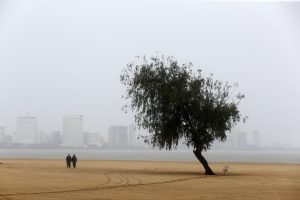The first cyclone in more than a century to hit India’s financial capital of Mumbai appeared to have largely spared the metropolis on Wednesday.
No deaths or major damages were reported as workers began clearing fallen trees and other debris from affected areas along India’s western coastline.
As Cyclone Nisarga crossed the central state of Maharashtra, live TV coverage showed inky black clouds framing the Arabian Sea, and trees swaying wildly as rain pounded coastal towns and villages.
In the state capital, Mumbai, home to Bollywood, India’s largest stock exchange and more than 18 million residents, high winds whipped skyscrapers and ripped apart shanties near the beach.
About 10,000 city residents were evacuated from their homes, municipal officials said. With powerful storms a rarity, there were no preexisting cyclone shelters, and many of the city’s large and sturdy buildings have already been converted into coronavirus isolation or treatment facilities, National Disaster Response Force spokesman Krishan Kumar said.
“We moved people to other strong buildings where there is a supply of water,” he said.
Such storms are less common in the Arabian Sea than on India’s east coast, and usually form later in the year. But Nisarga may represent ways in which the warming of oceans due to climate change is already altering lives, experts said.
In the hours before the storm hit India’s shores, drivers and peddlers deserted Mumbai’s iconic Marine Drive, fishermen yanked their nets out of the wavy Arabian Sea and police shooed people away from beaches.
Homes in city slums were boarded up and abandoned, and officials patrolled the streets, using bullhorns to order people to stay inside.
Nisarga brought heavy rain and sustained winds of 100 to 110 kilometers (62 to 68 miles) per hour through Wednesday afternoon after slamming ashore near the city of Alibag, about 98 kilometers (60 miles) south of Mumbai, the Meteorological Department said.
In Alibag, photos posted on Twitter by the disaster agency showed toppled carts, fallen trees scattered over roads and tin roofs ripped apart.
Alibag absorbed some of the storm’s power, reducing its impact on Mumbai, said Madhavan Rajeevan, secretary at the Ministry of Earth Sciences.
The storm moved away from the city across Maharashtra state with its wind speed slowing to 85 kilometers (52 miles) per hour.
Ahead of the storm, about 100,000 people were evacuated from low-lying areas in Maharashtra and neighboring Gujarat. Both states, already among the hardest hit by the coronavirus pandemic, activated disaster response teams, fearing extensive flooding could further impair overwhelmed health systems.
“If hospitals and clinics are damaged by the cyclone, the city won’t be able to cope with the large number of COVID-19 cases, and social distancing measures will become virtually impossible to follow,” Bidisha Pillai, chief executive of Save the Children in India, said in a statement.
About 200 COVID-19 patients in Mumbai were moved from a field hospital beneath a tent to another facility to avoid the risk of strong winds, officials said.
S.N. Pradhan, director of India’s National Disaster Response Force, said social distancing norms were being followed in evacuation shelters.
“Let us fight this danger like we are standing up to the corona pandemic and are on our way to defeat it. Likewise, we will prevail over this situation too!” Maharashtra’s top official, Chief Minister Uddhav Balasheb Thackeray, tweeted.
Maharashtra, which accounts for more than a third of India’s coronavirus cases, has seen the rate of infection slow in recent days, below India’s national average.
Officials in Mumbai and also in the central government in New Delhi have pinned hopes of an economic turnaround on a dramatic ease of restrictions this week after nine weeks of lockdown. India has reported more than 200,000 cases and 5,800 deaths due to the virus, and epidemiologists predict that the peak is still weeks away.
Nisarga comes just two weeks after Cyclone Amphan tore through the Bay of Bengal on India’s east coast and battered West Bengal state, killing more than 100 people in India and neighboring Bangladesh.
The frequency of cyclones in the Arabian Sea is predicted to increase, said Adam Sobel, a climate scientist at Columbia University.
The temperature of the top layer of the sea, from which the cyclone draws its energy, is “unusually high,” said K.J. Ramesh, former chief of India’s Meteorological Department. Much more frequent and intense cyclones have been appearing over a shorter time in recent years due to climate change, he said.
“Forecasting such storms becomes a challenge,” he said.
By Rafiq Maqbool, Emily Schmall, and Aniruddha Ghosal for the Associated Press. Schmall and Ghosal reported from New Delhi. Associated Press writer Chonchui Ngashangva in New Delhi contributed to this report.

































